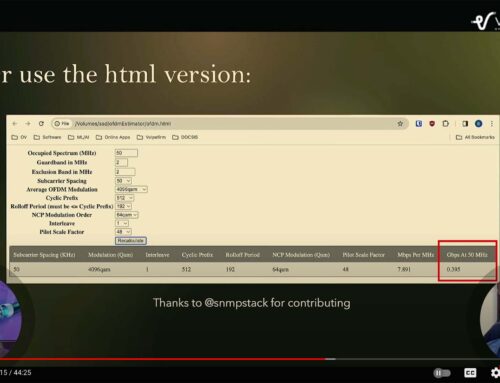Podcast: Play in new window | Download | Embed
Subscribe: Spotify | Email | RSS | More
Dynamic Range Window (DRW) and OFDMA Upstream Troubleshooting. Tips, suggestions and recommendations. Another power hour of cable with Brady Volpe and John Downey CMTS Technical Leader at Cisco. More and more operators are introducing OFDMA into their networks and experiencing a learning curve with its introduction and Dynamic Range Window issues. Find out ways to overcome these issues and ask any questions you may have.
The discussion is on all things DOCSIS. Basic recap of Dynamic Range Window also see our previous OFDMA podcast or live stream.
Dynamic Range Window OFDMA “UPSTREAM” Troubleshooting:
- Intro
- DOCSIS 3.1 US OFDMA Power Level High Points
-
Cable Modem Upstream Tx level reported in 1.6 MHz eq BW (even for SC-QAM)
-
SCM Phy Norm will adjust
-
-
Max 10 dB delta between 6.4 MHz ch & OFDMA on same controller
-
More US spectrum = greater coax attenuation & tilt from Cable Modem to CMTS
-
US Tx levels
-
DOCSIS 2.0 max Tx = 54 dBmV
-
DOCSIS 3.0 max Tx; 4-ch = 51 dBmV, 8-ch = 48 dBmV (Note: DOCSIS 3.0 & < based on modulation)
-
DOCSIS 3.1 max Tx = 65 dBmV total pwr
-
-
-
Dynamic Range Window (DRW) of 12 dB could be concern with much more potential spectrum allocation (up to 204 MHz) vs 85 for D3.0
-
DRW is different for DOCSIS 3.1 vs DOCSIS 3.0 IRT +/-6 for DOCSIS 3.0, but not same for DOCSIS 3.1
-
-
- CMTS Config “Band-Aids” & TCS Selection
-
No US ALC/AGC
-
Relying on CM/CMTS long-loop-level control and Cable Modem 12 dB Dynamic Range Window
-
Typical +/-2 dB swing @ 42 MHz (annual thermal fluctuations) w/ 4000’ coax
-
CMTS Upstream level settings and adjustable range
-
-
Note: OFDMA level displayed on analyzer affected by amount of traffic
-
Have seen where level does not match expected unless peak hold & send enough PRBS traffic to reach 70-90%
-
More testing needed with zero-span, FFT, longer dwell time/slower sweep speed, etc.
-
-
- Potential Fixes for Higher Upstream Freqs
-
No coax and move to stable 70o environment
-
Flexible Solution Taps (FST) – EQs & InvEQs for levels & Dynamic Range Window issues
-
Field Equalizers (FEQs) at least
-
EQ from 5 -1.2 GHz, no cutoff & grp delay or concern for diplex changes later
-
-
-
Thermal issues
-
Underground cable
-
Passives still above ground and experience slight temp fluctuations
-
-
Upstream thermal EQs to help stabilize negative fluctuations on cold days
-
Higher noise floor assuming aerial plant
-
-
Idea of US AGC driven by DS AGC circuitry or Intelligent-Amp
-
- DOCSIS 3.0 with Extended Pwr ECN = 3-6 dB more Upstream Tx w/54 dBmV typical
-
DOCSIS 3.1 is ~ 5 dB more power per equivalent 8-ch DOCSIS 3.0 Cable Modem
- Typical DOCSIS 3.0 Cable Modem Upstream Tx Levels
- Typical DOCSIS 3.1 Upstream Tx Levels Based on 1.6 MHz Equivalent BW Off High-Value Tap
- DOCSIS 3.1 Upstream Tx Levels with OFDMA Off High-Value Tap
- Typical DOCSIS 3.1 Upstream Tx Levels Based on 1.6 MHz Equivalent BW Off Low-Value Tap
- DOCSIS 3.0 Dynamic Range Window (DRW)
-
During initial ranging on chs being added by TCC encodings, Cable Modem MUST cover entire Dynamic Range Window within 16 retries, leaving no power interval greater than 6 dB untried
-
So for DOCSIS 3.0, by commanding power to mid of window it allows to go either 6 dB above or 6 dB below, which will cover whole 12 dB window
-
DOCSIS 3.0 uses a per-ch Dynamic Range Window, whereas DOCSIS 3.1 uses a single Dynamic Range Window for all chs in TCC
-
DOCSIS 3.0 allows bit more flexibility to shift Dynamic Range Window slightly for each ch if need be
-
- DOCSIS 3.1 Dynamic Range Window (DRW)
-
CMTS normally administers Dynamic Range Window of 12 dB [DOCSIS MULPIv3.1] which is sufficient to accommodate plant tilts of up to 10 dB from lower to upper edge of US band
-
Since fidelity requirements are specified in flat freq conditions from top of Dynamic Range Window, it’s desirable to maintain Cable Modem Tx power levels as close to top of Dynamic Range Window as possible
-
DOCSIS 3.1 uses single Dynamic Range Window for all chs in TCC
-
Three types of Dynamic Range Window violations reported by BRCM DOCSIS 3.1 Cable Modem
-
- 3 Types of Dynamic Range Window Violations Reported by BRCM DOCSIS 3.1 Cable Modem
-
Type 1:REG-RSP-MP Mismatch Between Calc Value for P1.6hi Compared to CCAP provided value
-
Uncommon & have not seen this reported recently. It could indicate that CMTS has recalculated value of P1.6hi for some reason (should not happen unless Cable Modem’s TCS has changed)
-
Does not imply loss of service
-
If TCS changes, it is expected
-
Type 2:RNG-RSP Commanded Power Exceeds Value Corresponding to Top of Dynamic Range Window
-
Indicates CMTS sent RNG-RSP with commanded power for 1 or more chs exceeding Dynamic Range Window max
-
May be printed by Cable Modem once or twice in event of Dynamic Range Window adjustment
-
However, if continuously printed by Cable Modem, that indicates problem that should be investigated
-
Type 3:RNG-RSP Commanded Power in Excess of 6 dB Below Value Corresponding to top of Dynamic Range Window
-
Indicates one or more chs in TCS has a commanded power value in lower half of Dynamic Range Window
-
More of an informative message, and benign
-
Indicates there may be Upstream power tilt in plant
-
May also be seen in lab with very low attenuation
-
Dynamic Range Window could be at spec min (range of 17 – 29 dBmV) & Cable Modem may be transmitting in lower half of that range
- Closing Points
-
Larger OFDMA chs will have same MER as 6.4 MHz, but max power issues
-
Could possibly configure lower CMTS Rx level on per-ch basis with pitfall of MER affect
-
What about 2 smaller blocks instead of 1 large block
-
More overhead and wasted resources
-
-
-
Is it better to do init ranging on lower freqs, middle or higher?
-
IR freq can be set & very robust modulation (BPSK), but low freqscan be very noisy
-
Very high freqs have more attenuation & TCS selection intended may not happen
-
IR will affect/dictate Dynamic Range Window
-
FR uses QPSK and scattered thru entire ch spectrum
-
-
-
Using lower freq for OFDMA Initial Ranging (IR) may help with Dynamic Range Window
-
Pre-EQ apparently not part of Dynamic Range Window
-
-
T4 multiplier
-
Step attenuators & house filter
-
FSTs are good for Dynamic Range Window, but caution advised for end-of-line designs
End Podcast
John thank you for your time today. This was a great episode. Our next Episode 75 in May 21th
You can watch us live or recorded on Youtube or listen to us on your favorite podcaster. Links to everything is on the volpefirm.com webpage.
If you have enjoyed this webcast, please do hit the subscribe button so that you never miss an episode.
Thank you so much for being here and we will see you next month.
Upcoming events can be seen under Broadband Events. Previous events can be seen under the blog.
- If you are watching this on youtube please hit the subscribe button!
- Let us know what you think and remember to share!
- You can find slides at the bottom of the page and some on slideshare.
- Find out about events or articles by following us on Twitter, LinkedIn or Facebook too.
Also available on iTunes, Google Podcasts, Spotify, vurbl see podcasts “get your tech on”.
[pdf-embedder url=”https://volpefirm.com/wp-content/uploads/2021/04/DRW-Podcast.pdf” title=”Dynamic Range Window Podcast”]




Leave a Reply